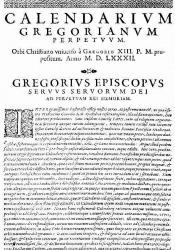Gregorian Calendar
The most common calendar in the world, the Gregorian Calendar, was introduced in 1582 in Catholic Europe by Pope Gregory XIII to replace the Julian calendar, which did not align exactly with the solar year and caused holidays to not fall in alignment with astronomical events or seasons. The calendar consists of 365 days broken up into 12 months of 28, 30, or 31 days, excepting leap years in which an extra day is added to make 366. The main goal of this calendar was to realign religious holidays with equinoxes and solstices. To accomplish this, the system of leap years was changed from every four years to slightly less than that, with the leap year being omitted every turn of a century, unless the year is divisible by 400. Additionally, the calendar has a more accurate way of calculating the date of Easter each year. In order to transition to the new system and line it up with the Earth, 10 days in October 1582 were not observed. Protestant countries were worried the new system was a scheme of the Catholic church to silence them, and so abstained from the change until 200 years later in 1752, when they joined the Catholic countries on the new calendar. Although the Pope enforced the new calendar, it was actually designed by Luigi Lilio, an Italian doctor, astronomer and philosopher. This calendar is accurate to one day every 3236 years, one of the best attempts humanity has made at a perfectly accurate calendar.
Source: “The Gregorian Calendar.” 2018. https://www.timeanddate.com/calendar/gregorian-calendar.html. Accessed 7 Mar 2018.
Image: Wikipedia Commons, public domain. https://commons.wikimedia.org/wiki/Gregorian_calendar

